4 Levels of Effective ServiceNow® Platform Implementation
The alluring benefits of using ServiceNow infrequently make CIOs investigate how to implement ServiceNow in their organizations. And sometimes this requires more than just finding the stages that ServiceNow implementation projects cover, such as implementation consulting, pilot projects, configuration and customization, integrations, data migration, user training and after-launch support.
The vast selection of ServiceNow functionality packages and the considerable savings they promise make CIOs wonder how they can identify the right implementation scope to benefit from the platform most. To that end exclusively, ScienceSoft’s ServiceNow implementation specialists have designed a proprietary 4-level ServiceNow implementation model that considers companies’ varying business natures and needs to propose optimal scopes.
A quick model overview
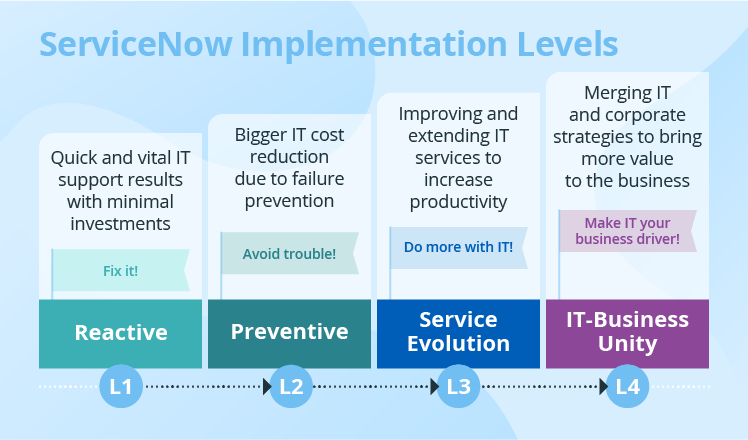
Having analyzed a pool of ServiceNow customers, we compiled a list of factors that determine companies’ ServiceNow-related business needs and influence the scope of the needed implementation. The top two defining factors were IT management maturity and organizational complexity.
Then, we analyzed how these factors take different forms in various companies. This helped us to segment the pool of organizations who can benefit from ServiceNow and describe an approximate implementation scope (or level) for each segment. Targeted at the needs of each company segment, every level presupposes a relevant ServiceNow functionality set and brings conceivable implementation outcomes.
Level 1 – Reactive
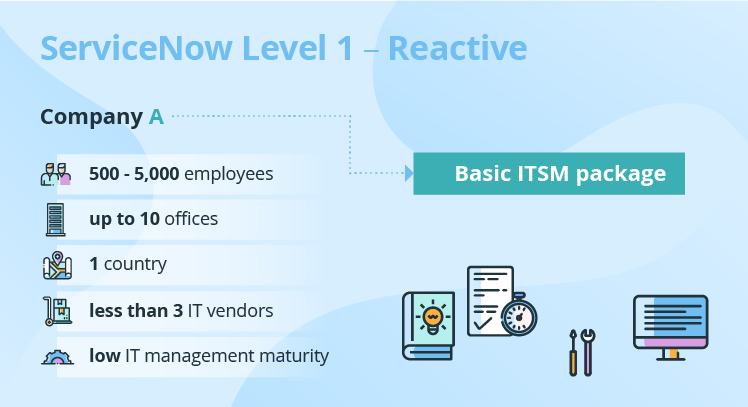
This segment’s representatives usually have from 500 to 5,000 employees with up to 10 offices, operate in one country and work with less than 3 IT vendors.
The company ‘before’
The company of this segment typically demonstrates low IT management maturity: there is no actual visibility into the IT infrastructure and IT processes are quite chaotic. This can be the case when a company establishes their IT processes while being a small or even mid-sized business and then fails to change them with the company’s physical and hierarchical growth. Naturally, this results in uncontrollable IT service outages, which makes businesses have no trust in IT at all.
The company’s needs
The main problem the company faces is a costly business process disruption due to long downtimes. So, they want to increase IT service availability by processing and managing tickets faster to cut downtimes and enable their end users to work with fewer interruptions.
Besides, the company plans to improve their IT management maturity further than Level 1 to get more benefits out of ServiceNow.
Involved ServiceNow products
The Reactive level strictly concerns ServiceNow’s basic ITSM package and includes:
- Incident Management (removing malfunctions quicker and increasing IT service availability).
- Knowledge Management (accumulating knowledge on incident resolution and sharing it with the entire IT support team and end users).
- Service Level Management (tracking the speed of incident resolution and checking its compliance with the established quality of service).
- Request Management (fulfilling end users’ IT-related requests).
- Configuration Management (keeping track of all IT infrastructure elements and solving incidents faster knowing the interrelations between them).
- Reports and dashboards (getting insights into IT support performance).
The company ‘after’
Due to implementing Level 1, the company achieves these results:
- Improved IT service availability that brings about the reduction of costs associated with business process disruption (e.g., a B2C company loses much less revenue because CRM outages are promptly removed).
- Increased end user productivity fostered by IT service stability that may lead to a mild revenue increase.
- Better user satisfaction (concerning both end users and IT support agents), which positively influences job satisfaction and ensures ServiceNow adoption.
- Established essential ServiceNow processes that serve as a ground for further IT improvement.
Implementation preparation
The company needs to hold training sessions to explain the new concepts of a ServiceNow solution to their IT support. These sessions may need to justify differentiating between two ticket types (incidents and requests), learning to rely on ServiceNow’s automated workflows and even being people- and process-oriented. Besides, the company should inspect the quality of any data they are going to import into ServiceNow.
Estimation
How long does ServiceNow implementation take?
A ballpark estimate of the duration of your Level 1 project can make up 4 months (with a limited amount of needed customizations and no project blockers involved). This period covers all stages of the usual ServiceNow implementation process.
How much does ServiceNow implementation cost?
Realized closely to out-of-the-box (OOTB) ServiceNow, the implementation of a Level 1 solution can cost about $35,000 with consulting, integrations and testing also included. This is, however, a rough estimation. To get the precise cost of your ServiceNow implementation project, you can contact our specialists.
Read more: Flexible ServiceNow Pricing - Factors, Costs, Price Examples
Level 2 – Preventive
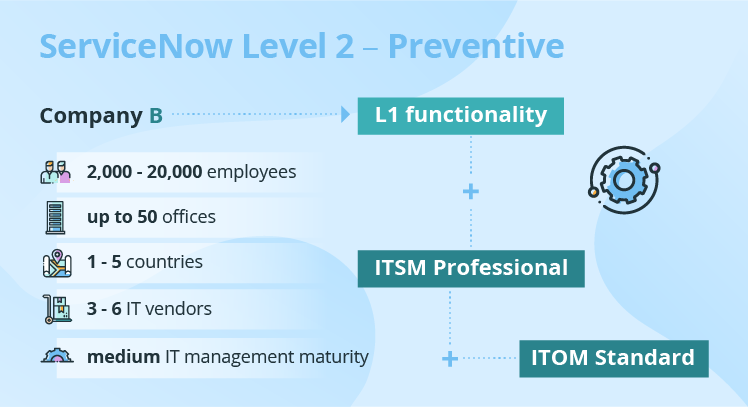
The company in this segment has up to 50 offices, employs between 2,000 and 20,000 people, runs a business in 5 or fewer countries and cooperates with 3 to 6 IT vendors.
The company ‘before’
The well-being of the IT infrastructure is a critical component of the company’s success, which – together with a forming process for introducing IT changes – indicates a medium level of IT management maturity. However, it doesn’t remove the increasing IT spending and the disruption of critical business processes that can cost as much as $300,000 per hour.
The company’s needs
While the company evolves, IT support becomes overloaded with a constantly increasing number of incoming incidents. Paradoxically, hiring more IT personnel to solve incidents faster doesn’t help to increase IT service availability much. Instead, the company needs to stop putting out IT fires and start preventing incidents. This marks the transition from IT support-centered thinking to the real IT service management.
IT support overload is also caused by excessive manual data entry that not only takes up support agents’ time for solving or preventing incidents but also leads to data errors spoiling workflow automation and reporting. So, IT support operations need new automation possibilities.
Involved ServiceNow products
Level 2 involves all the functionality associated with Level 1 and extends to ITSM Professional and ITOM Standard packages. The ITSM Professional part includes:
- Problem Management (searching for and removing the root causes of similar incidents to prevent any more incidents of the same nature).
- Change Management (introducing changes to the IT infrastructure to remove the root causes of problems).
- Agent Intelligence (using machine learning capabilities to automatically route incidents, identify incident categories and so on).
- Performance Analytics (enhancing analytics capabilities to recognize and forecast IT performance trends and manage IT support accordingly).
- Walk-up Experience (managing another reach-out channel – an onsite IT walk-up center).
- Asset Management (managing asset life cycles to reduce IT inventory-related costs).
- Service Catalog and Service Portal (providing a user-friendly web portal with a visual matrix of available IT services to enable employees to interact with IT units easier).
ITOM Standard modules:
- Discovery (automatically scanning the whole IT infrastructure and adding revealed info into Configuration and Asset Management).
- Event Management (automatically monitoring failures in the IT infrastructure to identify issues that require IT service agents’ attention).
The company ‘after’
Implementing the Preventive level, the company:
- Cuts business disruption costs by preventing incidents and improving IT service availability.
- Improves IT support productivity through raising IT support’s awareness of all changes in the IT infrastructure and automating data entry and other repetitive tasks.
- Reduces IT costs by optimizing IT support operations and allocating assets more efficiently.
- Plans future IT service management needs by forecasting IT performance trends to allot resources accordingly.
All this contributes to achieving highly stable IT service delivery across the organization.
Implementation preparation
The company needs to help their financial and IT specialists to understand the benefit of running IT asset management outside of enterprise-wide asset management. The IT team may also find the concepts of change and problem management, walk-up tracking, advanced analytics and machine learning excessive, so the company needs to hold dedicated user training to justify the necessity of these activities and show the trainees how to benefit from applying them.
Level 3 – Service Evolution
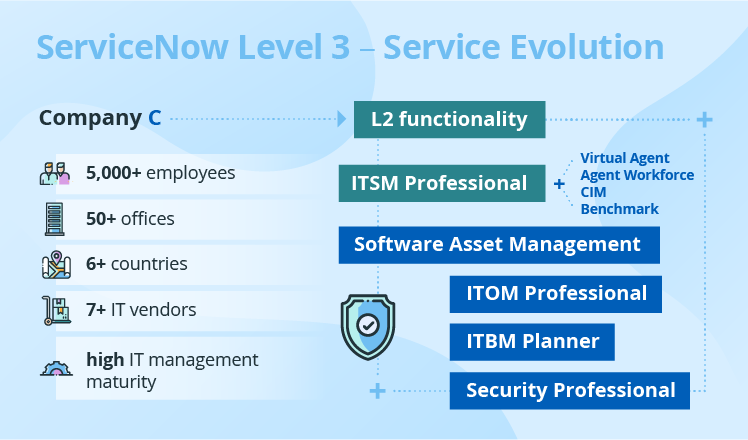
This segment’s company typically starts at 5,000 employees with over 50 offices across 6 or more countries dealing with 7+ IT vendors.
The company ‘before’
The company views IT as a vital condition for business success. IT service delivery is stable. However, there’s no fixed process of evaluating IT service efficiency. So, it’s impossible to understand where the company’s IT services need to improve. And that potentially means missed opportunities for increasing company-wide business workflow efficiency.
The company’s needs
The company needs to establish processes for monitoring and improving IT service efficiency. Additionally, the increased complexity of their IT infrastructure and the highly restricted ticket resolution time call for backing IT service management up with more productivity tools.
The company faces high IT costs outside of IT service management: IT vendors, in-house development and cybersecurity issues are not managed properly, which is a financial black hole. So, the company needs to ditch it by transferring their whole IT management into ServiceNow.
Involved ServiceNow products
Service Evolution builds on top of Level 2 functionality and involves other ServiceNow features and packages, namely additional ITSM Professional modules as well as Software Asset Management, ITOM Professional, ITBM Planner and Security Professional.
ITSM Professional:
- Virtual Agent (quickly resolving common issues with a chatbot).
- Agent Workforce (improving IT service agents’ productivity with an intuitive workspace).
- Continual Improvement Management (tracking and implementing IT service improvement ideas).
- Benchmarks (comparing IT support performance against average industry measurements to back service improvements).
Software Asset Management will help to monitor software license usage to distribute licenses adequately.
ITOM Professional:
- Orchestration (automating IT infrastructure-related tasks outside ServiceNow, such as software distribution or password resets).
- Operational Intelligence (supplementing Event Management with machine-learning capabilities to predict outages).
ITBM Planner:
- Agile Development (tracking and managing software development efforts of internal and external teams).
- Test Management (monitoring and managing all testing activities of both in-house and external QA teams).
- Resource Management (allocating resources and maintaining IT staff availability).
- Project Portfolio Management (planning and prioritizing projects as well as managing their execution).
Security Professional:
- Security Incident Response (tracking, prioritizing and removing security threats).
- Trusted Security Circles (sharing threat data with trusted recipients across the supply chain or the industry to increase awareness and remove possible breach points).
- Vulnerability Response (tracking, prioritizing and responding to security vulnerabilities).
The company ‘after’
Implementing Service Evolution can bring these results:
- Driving more benefit from IT by identifying service improvement opportunities as well as timely enacting and evaluating the efficiency of related changes.
- Increasing IT department productivity with a clear framework for building new efficient IT workflows.
- Cutting IT costs by:
- Automating IT operations.
- Thoroughly managing development and testing efforts delivered both internally and externally.
- Timely removing uncovered security threats and vulnerabilities.
Implementation preparation
Service Evolution requires a wave of digital transformation. IT gains an even more important role within the business, which is bound to require user training for all stakeholders involved. Particular problematic points may be chatbots, industry benchmarks, failure prediction and the need to share threat info with third parties.
Level 4 – IT-Business Unity
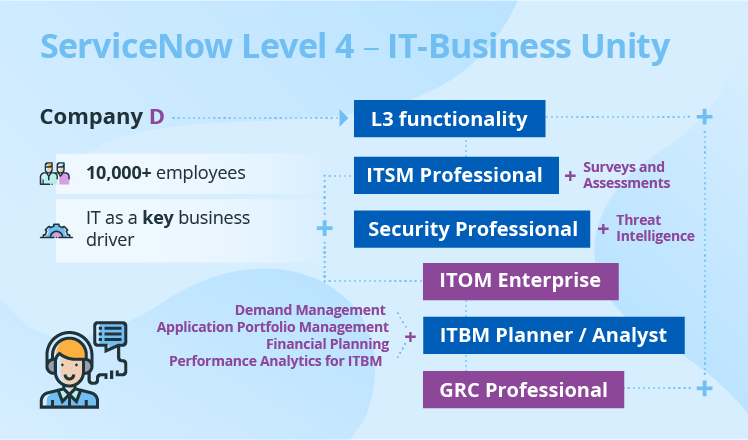
The companies of this segment vary in character a lot. Some are huge groups of companies or multi-business enterprises, while others are smaller businesses starting from 10,000 employees.
The company ‘before’
The company is bound to be highly IT-dependent and digitalized. Given the specifics of their business (banking, insurance, retail, etc.), they need reliable and dynamic IT as it builds the basis of their major competitive advantages. To make IT serve their business goals most pertinently, the company should merge their IT and business strategies.
The company’s needs
To align business goals with IT better, the company needs an established process for introducing new IT services with thorough requirement elicitation and IT service concept design.
IT costs (associated with software license spending as well as in-house development, testing and support activities) need to be optimized to spare the budget for supporting the introduction of new IT services.
The extreme IT infrastructure complexity makes it difficult to prepare for and pass governmental, independent and vendor assessment audits, so the company needs a relevant ServiceNow process supported by all required data.
Involved ServiceNow products
Reusing the functionality of Service Evolution, the IT-Business Unity level adds more features of such packages as ITSM Professional and Security Professional and also involves ITOM Enterprise, ITBM Planner or Analyst (depending on the access level needed) and Governance, Risk and Compliance Professional.
ITSM Professional:
- Surveys and Assessments (gathering end user feedback, identifying improvement opportunities and increasing end user satisfaction).
ITOM Enterprise:
- Cloud Management (monitoring and reducing cloud-related costs).
- Service Mapping (binding each IT infrastructure element to a business service to analyze failure impact better).
ITBM Planner/Analyst:
- Demand Management (gathering ideas for new IT services from the business, prioritizing and implementing them).
- Application Portfolio Management (monitoring available applications to ensure their alignment with the corporate strategy).
- Financial Planning (managing the budgets of all projects).
- Performance Analytics for ITBM (gaining deep insights into development, testing, project portfolio, etc.).
Security Professional:
- Threat Intelligence (looking for and analyzing low-lying security threats and attacks).
Governance, Risk and Compliance Professional:
- Policy and Compliance Management (publishing policies and monitoring compliance).
- Audit Management (creating, prioritizing and carrying out audit plans).
The company ‘after’
The IT-Business Unity level helps the company to:
- Consider IT not only as a cost center but also as a strategic investment opportunity with a clear understanding of its financial and marketing outcomes.
- Make all relevant business processes rely on IT to increase employee productivity and bring more revenue.
- Analyze all IT service consumption data available to improve and introduce new IT services.
- Establish a well-functioning process for routine IT service launches and removals to respond to business needs faster.
- Boost IT productivity by not wasting resources on the projects, applications and services that are no longer necessary.
- Improve IT service management productivity with new infrastructure dependency maps to find problem root causes and analyze the impact of changes and incidents faster.
- Cut IT costs and spare budget for new IT service launches by managing deeper security threats and project budgets, automating more IT operations and managing cloud-related spending.
- Ensure corporate policy compliance and prepare for government, independent and vendor audits easier.
- Increase end user satisfaction by analyzing and acting on end user survey results.
Implementation preparation
Similar to the Service Evolution level, Level 4 also requires a wave of digital transformation. IT needs to become highly agile and dynamic to support the company’s ever-changing business needs. The focus will be brought into IT costs as they will be as high as ever, so the company needs to prepare all the data concerning project budgets, applications and cloud usage. They also need to find and bring together all available policy and audit data rather likely stored in data silos. But most importantly, they need to set up free and eager communication between IT and business stakeholders to safeguard the success of demand management efforts.
The cautions to mind when applying the model
- This is a very general model targeted at 4 company segments to show the scope and the results of a possible ServiceNow implementation project. Thus, the model suits companies who both use and don’t use ServiceNow. Still, in reality, each level needs to be tuned to hit the company’s particular needs. For example, this project mostly demonstrates the characteristics of Level 1 with slight elements of Level 2.
- Practically no company can get to Level 3 or 4 right off, having no ServiceNow solution at all. You should perceive this model as a potential ServiceNow evolution roadmap where, starting from Level 1, you can go as high up as Level 4. However, you should consider your level needs thoroughly as you may target a level that offers something far more grandiose than you need. And a poor choice will result in a failed implementation project.
- Transgressing to the next level always requires substantial effort. Your IT support, IT department, and your entire organization may need to go through a massive culture change. So it is important to remember that level migration is always connected with IT management maturity increase, not just a physical company growth.

